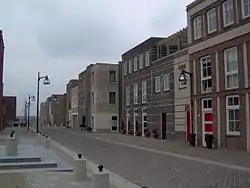Vinex-location
Vinex ("Vierde Nota Ruimtelijke Ordening Extra"; Fourth Memorandum on Extra Spacial Planning), is a policy briefing note of the Dutch Ministry of Housing, Spatial Planning and the Environment (Ministry of VROM) released in 1991.[1] Large outer city areas were pointed out by the policy for massive new housing development. Neighbourhoods built based on the note are known as Vinex-wijken (Vinex neighbourhoods).


To accommodate the increasing population in the Netherlands the Ministry of VROM determined a number of main points in the Vinex-document for the construction of new housing districts starting in 1993. New districts had to be placed near existing town centers and had to contribute to the following aims:
- Endorsement of existing malls (Increasing the potential number of customers)
- Limit the removals of unsatisfied inhabitants in medium-large cities
- Protection of open areas by concentrating the agglomerations around existing medium-large cities
- Limit traffic between residencies, work and stores (short distances offer more possibilities for public transport, bicycles and walking)
The Vinex-locations also had to diminish the unfair pricing of housing. This means that certain households live in housing that is too affordable when compared to their income, as a result of which these houses no longer become available to households with a lower income. So they tried to solve the shortage of affordable housing by luring wealthier households to the more expensive Vinex-locations. Nevertheless, the Vinex-locations had a determined share of affordable rentable houses.
References
- Jelte Boeijenga, Jeroen Mensink: Vinex Atlas, 010 Publishers, 200